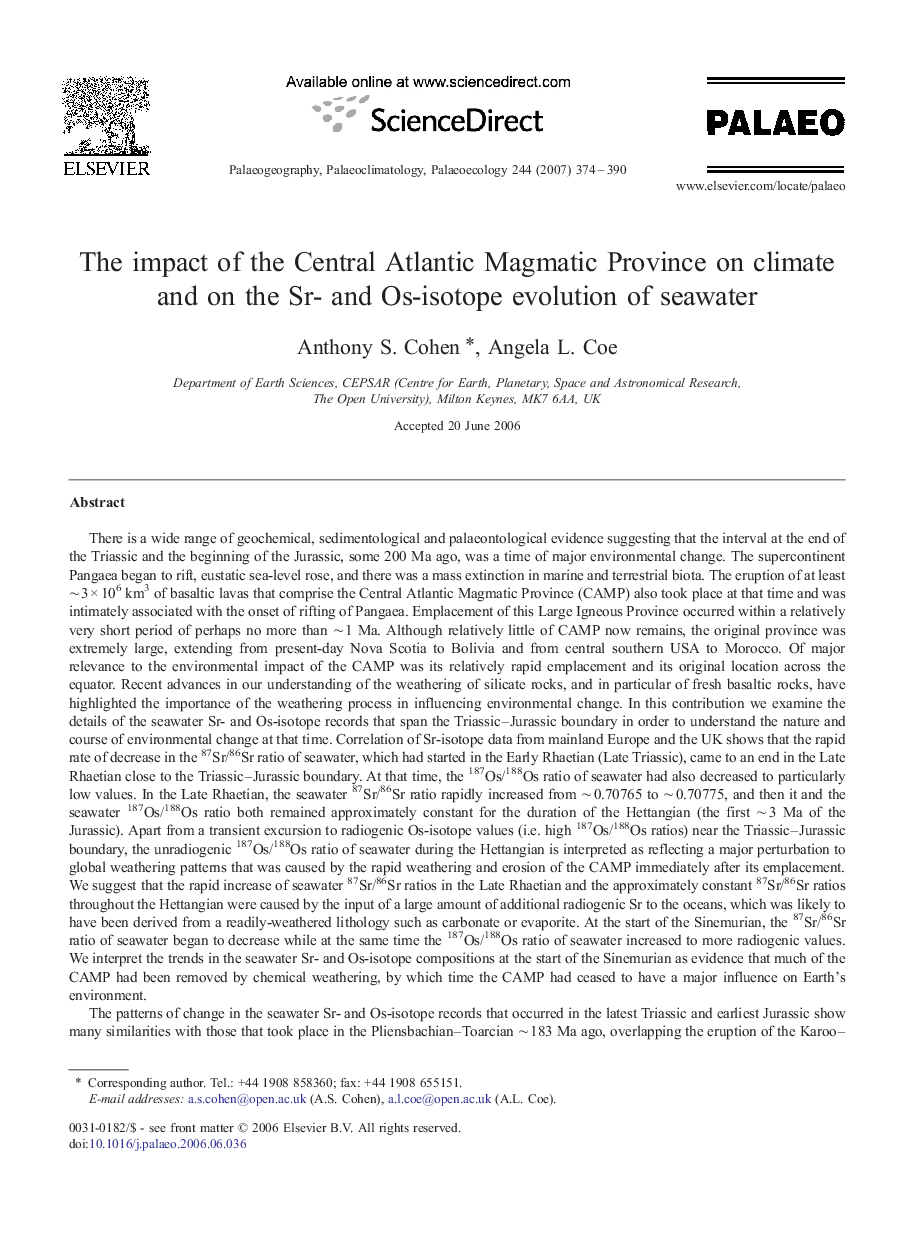| Article ID | Journal | Published Year | Pages | File Type |
|---|---|---|---|---|
| 4469241 | Palaeogeography, Palaeoclimatology, Palaeoecology | 2007 | 17 Pages |
There is a wide range of geochemical, sedimentological and palaeontological evidence suggesting that the interval at the end of the Triassic and the beginning of the Jurassic, some 200 Ma ago, was a time of major environmental change. The supercontinent Pangaea began to rift, eustatic sea-level rose, and there was a mass extinction in marine and terrestrial biota. The eruption of at least ∼ 3 × 106 km3 of basaltic lavas that comprise the Central Atlantic Magmatic Province (CAMP) also took place at that time and was intimately associated with the onset of rifting of Pangaea. Emplacement of this Large Igneous Province occurred within a relatively very short period of perhaps no more than ∼ 1 Ma. Although relatively little of CAMP now remains, the original province was extremely large, extending from present-day Nova Scotia to Bolivia and from central southern USA to Morocco. Of major relevance to the environmental impact of the CAMP was its relatively rapid emplacement and its original location across the equator. Recent advances in our understanding of the weathering of silicate rocks, and in particular of fresh basaltic rocks, have highlighted the importance of the weathering process in influencing environmental change. In this contribution we examine the details of the seawater Sr- and Os-isotope records that span the Triassic–Jurassic boundary in order to understand the nature and course of environmental change at that time. Correlation of Sr-isotope data from mainland Europe and the UK shows that the rapid rate of decrease in the 87Sr/86Sr ratio of seawater, which had started in the Early Rhaetian (Late Triassic), came to an end in the Late Rhaetian close to the Triassic–Jurassic boundary. At that time, the 187Os/188Os ratio of seawater had also decreased to particularly low values. In the Late Rhaetian, the seawater 87Sr/86Sr ratio rapidly increased from ∼ 0.70765 to ∼ 0.70775, and then it and the seawater 187Os/188Os ratio both remained approximately constant for the duration of the Hettangian (the first ∼ 3 Ma of the Jurassic). Apart from a transient excursion to radiogenic Os-isotope values (i.e. high 187Os/188Os ratios) near the Triassic–Jurassic boundary, the unradiogenic 187Os/188Os ratio of seawater during the Hettangian is interpreted as reflecting a major perturbation to global weathering patterns that was caused by the rapid weathering and erosion of the CAMP immediately after its emplacement. We suggest that the rapid increase of seawater 87Sr/86Sr ratios in the Late Rhaetian and the approximately constant 87Sr/86Sr ratios throughout the Hettangian were caused by the input of a large amount of additional radiogenic Sr to the oceans, which was likely to have been derived from a readily-weathered lithology such as carbonate or evaporite. At the start of the Sinemurian, the 87Sr/86Sr ratio of seawater began to decrease while at the same time the 187Os/188Os ratio of seawater increased to more radiogenic values. We interpret the trends in the seawater Sr- and Os-isotope compositions at the start of the Sinemurian as evidence that much of the CAMP had been removed by chemical weathering, by which time the CAMP had ceased to have a major influence on Earth's environment.The patterns of change in the seawater Sr- and Os-isotope records that occurred in the latest Triassic and earliest Jurassic show many similarities with those that took place in the Pliensbachian–Toarcian ∼ 183 Ma ago, overlapping the eruption of the Karoo–Ferrar igneous province. In both cases, the seawater Sr- and Os-isotope records indicate that there was a relatively very brief interval during which rates of continental weathering increased greatly. The similarities in the responses of the seawater Sr- and Os-isotope records at those times strongly suggest that the eruption and subsequent erosion of basaltic Large Igneous Provinces have played a major role in defining the course of environmental change in the past.
